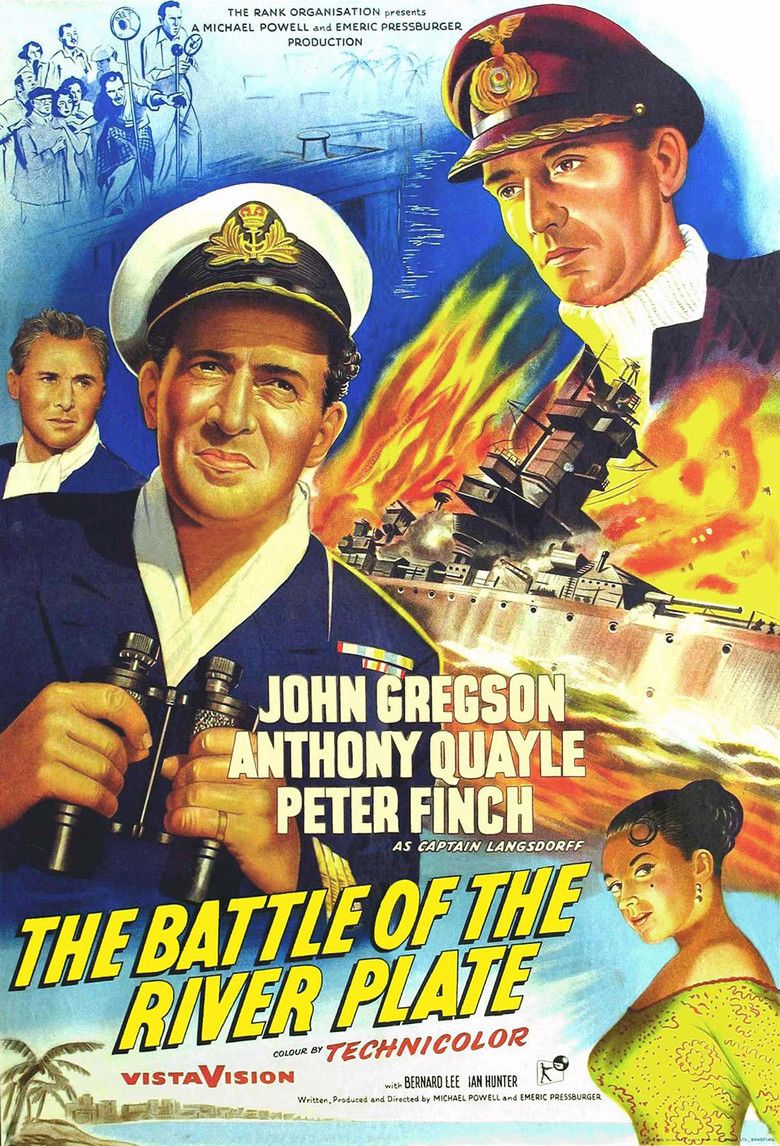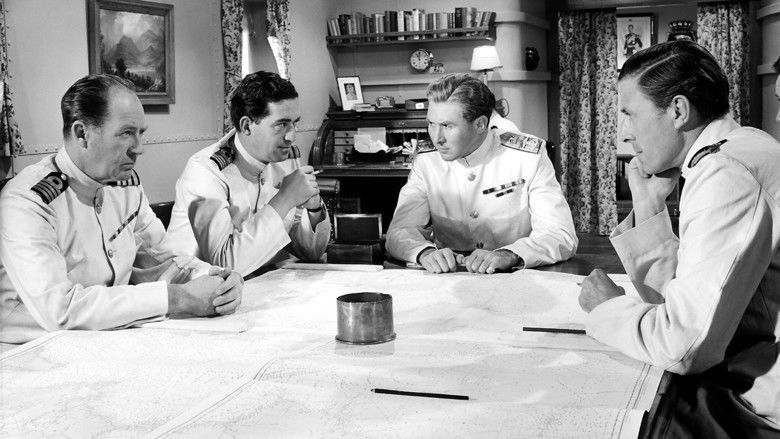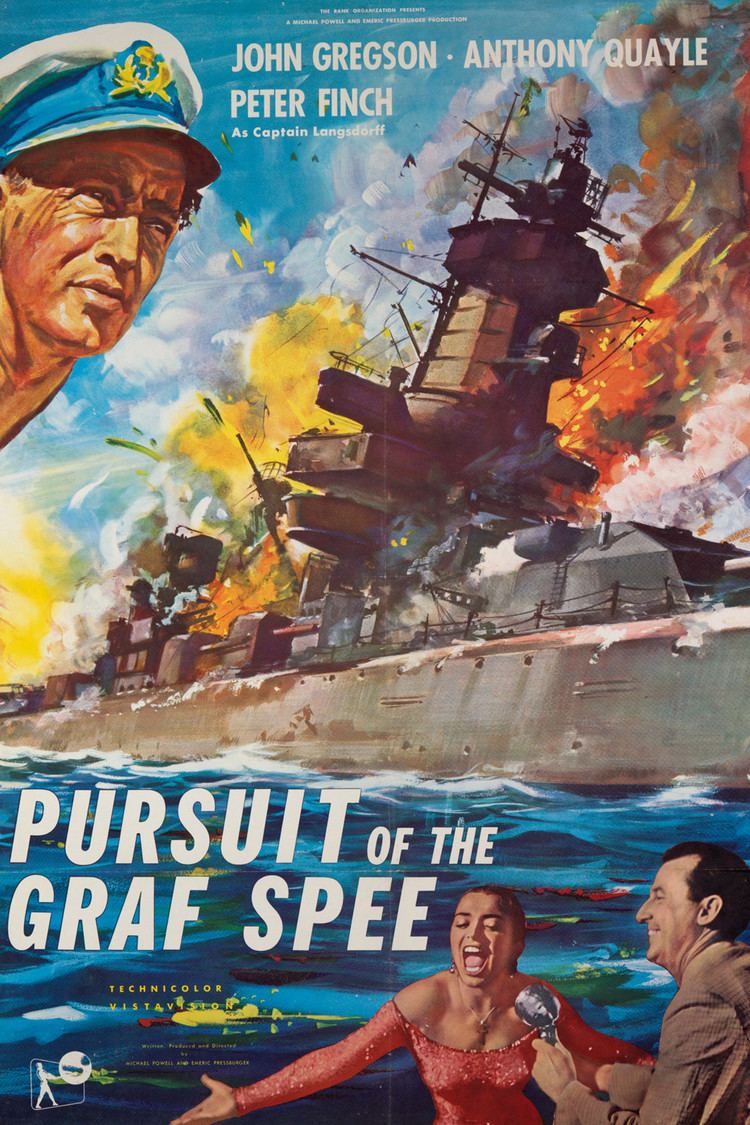The Battle of the River Plate (film)
7.2 /10 1 Votes
80% Rotten Tomatoes Genre Action, Adventure, Drama Duration Language English | 6.6/10 IMDb Country United Kingdom | |||||||||||||||||||||||||||||||||
 | ||||||||||||||||||||||||||||||||||
Director Michael PowellEmeric Pressburger Screenplay Michael Powell, Emeric Pressburger Cast (Captain Bell - H.M.S. Exeter), (Commodore Harwood - H.M.S. Ajax), (Captain Langsdorff 'Admiral Graff Spee'), (Captain Woodhouse - H.M.S. Ajax), (Captain Parry - H.M.S. Achilles), (Captain Dove - M.S. Africa Shell) Similar movies Tagline The tremendous story of the victory over the Graf Spee. | ||||||||||||||||||||||||||||||||||
The battle of the river plate 1956 sending ships to the bottom
The Battle of the River Plate (a.k.a. Pursuit of the Graf Spee in the United States) is a 1956 British war film in Technicolor and VistaVision by the writer-director-producer team of Michael Powell and Emeric Pressburger. The film stars John Gregson, Anthony Quayle, and Peter Finch. It was distributed worldwide by Rank Film Distributors Ltd.
Contents
- The battle of the river plate 1956 sending ships to the bottom
- Plot
- Ashore
- Production
- Ships used
- Historical details
- Release and reception
- Box office
- Awards and honours
- Book
- References

The film's storyline concerns the Battle of the River Plate, an early World War II naval battle in 1939 between a Royal Navy force of three cruisers and the German pocket battleship Admiral Graf Spee.

Plot

In the early months of the Second World War, Nazi Germany's Kriegsmarine sends out merchant raiders to attack Allied shipping. The Royal Navy responds with hunting groups whose mission is to stop them. The group that finds the heavily armed pocket battleship Admiral Graf Spee near South America is outgunned: Graf Spee is equipped with long-range 11-inch guns, while the British heavy cruiser Exeter has much lighter 8-inch guns, and the light cruisers Ajax and Achilles have 6-inch guns. Despite this, they go straight to the attack.
The British are led by Commodore Harwood (Anthony Quayle), with Captain Woodhouse (Ian Hunter) commanding flagship Ajax, Captain Bell (John Gregson) Exeter and Captain Parry (Jack Gwillim) Achilles. The British use their superior numbers to "split her fire" by attacking from different directions, but Graf Spee, under Captain Hans Langsdorff (Peter Finch), inflicts much damage on her foes; Exeter is particularly hard hit and is forced to retire.
However, Graf Spee sustains damage herself, and takes refuge in the neutral port of Montevideo, Uruguay to make repairs. According to international law, the ship may remain at neutral harbour only long enough to make repairs for seaworthiness, not to refit her for battle. With reinforcements too far away, the British spread disinformation that an overwhelming force is lying in wait, hoping to buy time: while they are initially demanding that the Uruguayan authorities send the Graf Spee out to sea within 24 hours, as the law dictates, they suddenly seem to lose interest and appear to tolerate her staying at anchor in Montevideo for as long as required. This is a bluff intended to make the Germans believe that more British warships are on the way, when none are. Taken in by this ruse, Langsdorff takes his ship out with a skeleton crew aboard, and as she heads down the River Plate for the open sea, he orders her scuttled.
Ashore
Production
The Battle of the River Plate had its genesis in an invitation to Michael Powell and Emeric Pressburger to attend a film festival in Argentina in 1954. They decided they couldn't afford to take the time from their schedules unless it was a working holiday, and used the trip to research the defeat of the Admiral Graf Spee. They came across the "hook" for their story when one of the surviving British naval officers gave Pressburger a copy of Captain Patrick Dove's book I Was A Prisoner on the Graf Spee, which became the basis of the human story of the film.
Principal photography began on 13 December 1955, the sixteenth anniversary of the battle. The HMS Ajax and River Plate Association reportedly sent a message to the producers: "Hope your shooting will be as successful as ours". Location shooting for the arrival and departure of the Graf Spee took place at the port of Montevideo, using thousands of locals as extras. However, the scenes showing Graf Spee sailing from Montevideo were shot in the Grand Harbour at Valletta in Malta, and the launch taking McCall out to HMS Ajax was filmed in Gozo harbour on Malta's northern island.
The Battle of the River Plate was shot in VistaVision, a wide screen orthographic process using a horizontal film feed.
Two songs written by composer Brian Easdale were used in the film, "Dolores' Song" and "Rio de la Plata". Both were acted by April Olrich as "Dolores", with singing voice dubbed by Muriel Smith.
Ships used
Most of the action of the battle and prior to it takes place on real ships at sea. The producers had the advantage of having elements of the Mediterranean Fleet of the Royal Navy available for their use, and USS Salem to play the part of Admiral Graf Spee, although she had a different number of main turrets. The producers did make use of a 23-foot model of Salem (with details only on the side being shot) in a six-foot-deep tank at Pinewood Studios for scenes depicting hits during the battle, and also for the blowing-up of Admiral Graf Spee, which was assembled from multiple takes from different angles.
In an early scene, it is claimed that the Graf Spee is being disguised by the ship's carpenters – using features such as a false funnel – as an American cruiser, a trick typical of commerce raiders. The US Navy would not allow any Nazi insignia to be displayed on the Salem so the wartime German flag being hoisted and flown was filmed on a British ship. This is also the explanation as to why the crew of the Graf Spee are seen wearing US Navy pattern helmets rather than German "Coal Scuttles" – whilst the film-makers wanted to achieve an accurate impression and use German helmets they were refused permission. This aspect is sometimes described as a "goof" on the part of the film-makers, but was in fact a circumstance beyond their control.
It was remarkable that two of the original ships, HMS Achilles and Cumberland were available for filming fifteen years after the events depicted. Cumberland was a disarmed trials ship without her 8" gun turrets at this time and was refitted with lattice masts, but she is very recognisable as the last of the three-funnelled heavy cruisers to remain in service. (In the final scenes, Jamaica represented Cumberland as one of the British trio waiting off Montevideo). This use of real warships was in line with an Admiralty policy of co-operation with film-makers, which saw the corvettes HMS Coreopsis and HMS Portchester Castle reactivated in 1952 for the film version of The Cruel Sea; the cruiser HMS Cleopatra and the minelayer HMS Manxman used in the 1953 film Sailor of the King, and the destroyer HMS Teazer and frigate Amethyst used in the 1955 film Yangtse Incident: The Story of H.M.S. Amethyst.
HMNZS Achilles had been sold to the newly formed Indian Navy in 1948, becoming the INS Delhi. The flagship HMS Ajax was actually her sister ship, and would have looked identical to Achilles, while the original HMS Exeter was a two-funnelled half-sister of the Cumberland. HMS Sheffield and HMS Jamaica, which played Ajax and Exeter, had higher superstructures and more guns, which were mounted in triple turrets. Though different from the ships they represented, both these light cruisers saw active service against much more powerful German battleships, including Bismarck in 1941, Hipper and Lützow (sister ship to Graf Spee) in 1942, and the sinking of Scharnhorst in 1943, as well as escorting carrier attacks against Tirpitz in 1944. Thus Sheffield and Jamaica had played a major part in the wartime campaign against the large German surface raiders which began at the Battle of the River Plate, and fully deserved their leading roles in this film.
Historical details
The use of real ships allows the film to pay particular attention to detail even though the Graf Spee was portrayed by the American heavy cruiser USS Salem which is visually distinct from the German Pocket Battleship. This includes the warning bells ringing before each salvo, the scorching on the gun barrels after the battle, and the accurate depiction of naval procedures. The film depicts Graf Spee and Altmark using the complex procedure of alongside refuelling; actually the Germans used the slower but safer method of astern refuelling, but the alongside method is much more dramatic for film purposes, and by 1955 was standard procedure for the British ships involved (see list above). Similarly, although the scene when Harwood meets with his captains on board Ajax is fictional, it was created for the movie in order to explain the tactical situation to the audience. The battle is seen from the perspective of the British ships, and that of the prisoners captured from nine merchantmen and held in Graf Spee.
The film devotes nearly twenty minutes to the battle, which actually lasted a little more than an hour before becoming a chase into Montevideo. The initial minutes from the spotting of Graf Spee at 0614, to her opening fire at 0618, and the British ships returning fire from 0620 are depicted in real time. In reality Graf Spee's gunfire did not "straddle" Exeter until 0623, after three salvoes, and her main armament fire was not "split" between the British ships until 0630, although these events are shown happening immediately. Exeter's bridge and forward turrets were knocked out at 0630, but at this point the film begins to telescope the sequence of events.
Commodore Harwood is shown wearing the shoulder tabs and sleeve rings of a Rear Admiral from the start, although he was only promoted to this rank after the battle. This is historically correct, as 'Commodores of the first class' wore those insignia at the time. Exeter's chaplain is also correctly depicted wearing a civilian dark suit and clerical collar; it was not until later in the war that naval chaplains adopted military uniform as a security measure.
The Battle of the River Plate only hints at one aspect of the story: the death of Captain Hans Langsdorff after he scuttled his ship. In the film Langsdorff is shown as subdued and depressed afterwards. In reality he was taken ashore to the Naval Hotel in Buenos Aires, where he wrote letters to his family and superiors. He then lay atop Admiral Graf Spee's battle ensign and shot himself, forestalling allegations that he had avoided further battle action through cowardice; another motivation was his desire, as Graf Spee's captain, to symbolically go down with his ship. He was talked out of this by his officers, who convinced him that his leadership was still needed in seeking amnesty for his crew. Once their fate was decided, Langsdorff was free to die as he had planned.
Hans Langsdorff was buried in the German section of the La Chacarita Cemetery in Buenos Aires, Argentina and was honoured by both sides in the battle for his honourable conduct.
Release and reception
When The Battle of the River Plate was completed and screened for executives at the Rank Organisation, it went over so well that it was decided to hold the release of the film for a year, so that it could be chosen as part of the next year's Royal Film Performance (in 1956), since 1955's film had already been selected. The royal premiere was held at the Odeon Leicester Square on 29 October 1956 in the presence of Queen Elizabeth II and Princess Margaret.
Box office
The film also performed very well at the box office, being the fourth most popular film in Britain in 1957, after High Society, Doctor at Large and The Admirable Crichton.
Awards and honours
The Battle of the River Plate was nominated for three BAFTA Awards in 1957, for "Best British Film", "Best British Screenplay" and "Best Film From Any Source".
Book
In 1956 Powell published Graf Spee with Hodder and Stoughton, a.k.a. Death in the Atlantic (Rinehart, US), retelling the story of the film in more detail. In 1976, a second edition was released by White Lion Publishers with the amended title, The Last Voyage of the Graf Spee.
References
The Battle of the River Plate (film) WikipediaThe Battle of the River Plate (film) IMDbThe Battle of the River Plate (film) Rotten TomatoesThe Battle of the River Plate (film) themoviedb.org
